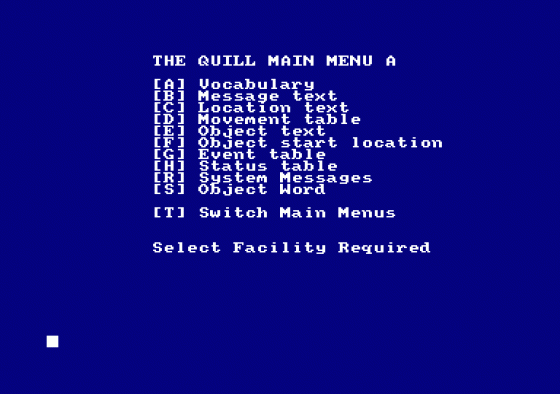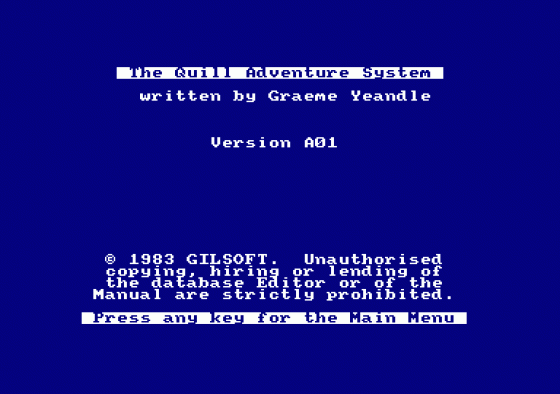
Amstrad Computer User
 1st May 1985
1st May 1985
Categories: Review: Software
Publisher: Gilsoft
Machine: Amstrad CPC464
Published in Amstrad Computer User #6
The Quill
I've never really considered myself to be much of an adventure nut. The first mention of how you got past the snake by throwing a bird at it is usually guaranteed to send me off to sleep - however after a couple of evenings using Gilsoft's The Quill, I can begin to see the appeal of adventures. I think the reason that a lot of people are initially put off adventures is their inability to get anywhere in the quagmire of convoluted problems that the majority of commercially available adventures contain. Getting behind the scenes and being able to set your own simple problems, I think, is going to appeal to a lot more people.
The idea that you may eventually create an adventure to equal any of those that you might buy is always an intriguing prospect, especially if that might include being able to sell it. The indications from the original Spectrum program are that this is a quite viable proposition.
A program that takes all the donkey work out of any low level programming task will always appeal to the thousands of people who can string together a couple of hundred lines of BASIC, but who would never think of attempting machine code. The Quill is just such a program. A program of this type is still no good if you need a degree in computing science to operate it and the acid test of a program's ease of use is to give it to someone who knows very little about programming, and to see how far he/she gets; in this case, my mum was the guinea-pig. After just one evening's use she had grasped the majority of concepts necessary to produce a working product.

Admittedly this was just the example six location adventure that is detailed in the manual, but as she pointed out; having seen exactly how this was constructed, it would be quite simple to adapt it to your own ideas, changing the messages and objects, and eventually expanding the range of locations and puzzles.
The adventure is built around a series of locations, each of which is given a number and a description supplied by you. It is then necessary to indicate how these are interconnected, and which words should be used to go from one to the next (East, West, North, South and so on).
Each of these locations may contain any amount of objects, and each is given a number and description. Special cases are provided for objects that may be worn or objects that produce light (e.g. a torch) etc.

All the verbs and nouns that will be recognised within an adventure are entered into the vocabulary, each being given a separate number. The Quill is really just a very specialised database management system and it is by controlling the interaction of all objects by means of the various number labels that the program functions.
The actual operation of the adventure is controlled by two tables: the event table and the status table. The first is used by the interpreter to hold word pairs that are to have a special action in the adventure (e.g. LIGHT LAMP). Each pair is followed by a list of conditions, and if these are all met when the two words are used then the list of actions is instigated. (e.g. LIGHTing the LAMP may now enable you to see the DIAMOND, but only if the CREST is OPEN - the conditions would be that the words LIGHT LAMP were entered and that OPEN CHEST had already been entered - the actions would be to make the DIAMOND a visible object then re-describe the location). The status table is very similar, except that the actions in it are not dependent on the typed input - only on other things such as the number of moves taken etc.
I think it is pretty fair to say that the manual supplied with The Quill is probably one of the best supplied with any computer product currently available (though the implication that the slowness of their editor is in some way caused by the print routines of the Arnold is quite obviously a terminological inexactitude). It is probably this, combined with its ease of use that made this program such a smash hit on the Spectrum - I can't see any reason why this won't also be the case for the Arnold.




